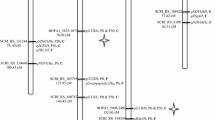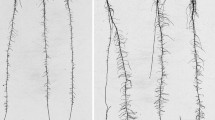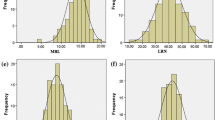Abstract
Root traits are important in improving nutrient and water use efficiency. Vertical root pulling resistance (VRPR) has been shown to be closely related to root system characteristics in maize (Zea mays L.). In the present study, two genetic populations derived from the same parents, one containing 218 recombinant inbred lines (RILs) and the other containing 187 advanced backcross BC4F3 lines, were genotyped using 184 SSR markers and evaluated for VRPR, grain yield (GY), stover yield (SY), and nitrogen uptake (Nup) under field conditions over 2 years. Our aims were (1) to locate QTLs associated with VRPR, SY, GY, and Nup, (2) to determine whether QTL detection is consistent between the BC4F3 and RIL populations, and (3) to identify backcross lines harboring favorable VRPR QTLs for use in future breeding programs. Using composite interval mapping (CIM), 12 and 17 QTLs were detected in BC4F3 and RIL populations, respectively. An important QTL region in bin 6.02 within the interval umc1006-umc1257 was found to control VRPR, SY, and Nup in both populations. These favorable alleles were contributed by the large-rooted parent Ye478. A significant positive correlation was detected between VRPR, SY, and Nup, but not between VRPR and GY. Backcross lines harboring VRPR QTLs could be useful germplasm for developing near isogenic lines (NILs) and for map-based cloning of genes controlling root growth.



Similar content being viewed by others
References
Agrama HAS, Moussa ME (1996) Mapping QTLs in breeding for drought tolerance in maize (Zea mays L.). Euphytica 91:89–97
Arihara J, Crosbie TM (1982) Relationships among seedling and mature root system traits of maize. Crop Sci 22:1197–1202
Austin DF, Lee M (1996) Comparative mapping in F2:3 and F6:7 generations of quantitative trait loci for grain yield and yield components in maize. Theor Appl Genet 92:817–826
Beavis WD, Smith OS, Grant D, Fincher R (1994) Identification of quantitative trait loci using a small sample of topcrossed and F4 progeny from maize. Crop Sci 34:882–896
Beck DL, Darrah LL, Zuber MS (1988) Effect of sink level on root and stalk quality in maize. Crop Sci 28:11–18
Bertin P, Gallais A (2001) Genetic variation for nitrogen use efficiency in a set of recombinant inbred lines II—QTL detection and coincidences. Maydica 46:53–68
Bohn M, Novais J, Fonseca R, Tuberosa R, Grift TE (2006) Genetic evaluation of root complexity in maize. Acta Agron Hung 54:291–303
Chen J, Xu L, Cai Y, Xu J (2008a) QTL mapping of phosphorus efficiency and relative biologic characteristics in maize (Zea mays L.) at two sites. Plant Soil 313:251–266
Chen Y, Chao Q, Tan G, Zhao J, Zhang M, Ji Q, Xu M (2008b) Identification and fine-mapping of a major QTL conferring resistance against head smut in maize. Theor Appl Genet 117:1241–1252
Chun L, Mi G, Li J, Chen F, Zhang F (2005) Genetic analysis of maize root characteristics in response to low nitrogen stress. Plant Soil 276:369–382
Churchill GA, Doerge RW (1994) Empirical threshold values for quantitative trait mapping. Genetics 138:963–971
Duvick DN (1992) Genetic contributions to advances in yield of US maize. Maydica 37:69–79
Fincher RR, Darrah LL, Zuber MS (1985) Root development in maize as measured by vertical root-pulling resistance. Maydica 30:383–394
Guingo E, Hèbert Y, Charcosset A (1998) Genetic analysis of root traits in maize. Agronomie 18:225–235
Hallauer AR, Miranda JB (1981) Quantitative genetics in maize breeding. Iowa State University Press, Ames
Hébert Y, Barrière Y, Bertholeau JC (1992) Root lodging resistance in forage maize: genetic variability of root system and aerial part. Maydica 37:173–183
Ho JC, McCouch SR, Smith ME (2002) Improvement of hybrid yield by advanced backcross QTL analysis in elite maize. Theor Appl Genet 105:440–448
Hund A, Fracheboud Y, Soldati A, Frascaroli E, Salvi S, Stamp P (2004) QTL controlling root and shoot traits of maize seedlings under cold stress. Theor Appl Genet 109:618–629
Jenison JR, Shank DB, Penny LH (1981) Root characteristics of 44 maize inbreds evaluated in four environments. Crop Sci 21:233–237
Jordan WR, Dugas WA Jr, Shouse PJ (1983) Strategies for crop improvement for drought-prone regions. Agric Water Manag 7:281–299
Kaeppler SM, Parke JL, Mueller SM, Senior L, Stuber C, Tracy WF (2000) Variation among maize inbred lines and detection of quantitative trait loci for growth at low phosphorus and responsiveness to arbuscular mycorrhizal fungi. Crop Sci 40:358–364
Kamara AY, Kling JG, Ajala SO, Menkir A (2002) The relationship between vertical root-pulling resistance and nitrogen uptake and utilization in maize breeding lines. Maydica 47:135–140
Kamara AY, Kling JG, Menkir A, Ibikunle O (2003) Agronomic performance of maize (Zea mays L.) breeding lines derived from a low nitrogen maize population. J Agric Sci 141:221–230
Kenrick P (2002) The origin of roots. In: Waisel Y et al (eds) Plant roots: the hidden half, 3rd edn. Marcel Dekker, New York, pp 295–322
King J, Gay A, Sylvester-Bradley R, Bingham I, Foulkes J, Gregory P, Robinson D (2003) Modelling cereal root systems for water and nitrogen capture: Towards an economic optimum. Ann Bot 91:383–390
Knapp SJ, Stroup WW, Ross WM (1985) Exact confidence intervals for heritability on a progeny mean basis. Crop Sci 25:192–194
Landi P, Albrecht B, Giuliani MM, Sanguineti MC (1998) Seedling characteristics in hydroponic culture and field performance of maize genotypes with different resistance to root lodging. Maydica 43:111–116
Landi P, Sanguineti MC, Darrah LL, Giuliani MM, Salvi S, Conti S, Tuberosa R (2002) Detection of QTLs for vertical root pulling resistance in maize and overlap with QTLs for root traits in hydroponics and for grain yield under different water regimes. Maydica 47:233–243
Lebreton C, Lazic-Jancic V, Steed A, Pekic S, Quarrie SA (1995) Identification of QTL for drought responses in maize and their use in testing causal relationships between traits. J Exp Bot 46:853–865
Li JA, Feng FF (1994) Research of 3yc-1 dynamometer for maize stubble pull and stalk hardness. J Maize Sci 2:76–78 (in Chinese)
Li DH, Mao LH, Yang JS, Liu JG, Zhang YH (2005) Breeding process and utilization of excellent maize inbred line 478. J Laiyang Agric Coll 22:159–164 (in Chinese)
Li YL, Niu SZ, Dong YB, Cui DQ, Wang YZ, Liu YY, Wei MG (2007) Identification of trait-improving quantitative trait loci for grain yield components from a dent corn inbred line in an advanced backcross BC2F2 population and comparison with its F2:3 population in popcorn. Theor Appl Genet 115:129–140
Lincoln S, Daly M, Lander E (1993) Mapping genes controlling quantitative traits with MAPMAKER/QTL, 2nd edn. Whitehead Institute Technical Report
Liu JC, Li JS, Chen FJ, Zhang FS, Ren TH, Zhuang ZJ, Mi GH (2008) Mapping QTLs for root traits under different nitrate levels at the seedling stage in maize (Zea mays L.). Plant Soil 305:253–265
Liu JX, Chen FJ, Olokhnuud C, Glass ADM, Tong YP, Zhang FS, Mi GH (2009) Root size and nitrogen-uptake activity in two maize (Zea mays L.) inbred lines differing in nitrogen-use efficiency. J Plant Nutr Soil Sci 172:230–236
Mano Y, Omori F, Muraki M, Takamizo T (2005) QTL mapping of adventitious root formation under flooding conditions in tropical maize (Zea mays L.) seedlings. Breed Sci 55:343–347
Mechin V, Argillier O, Hebert Y, Guingo E, Moreau L, Charcosset A, Barriere Y (2001) Genetic analysis and QTL mapping of cell wall digestibility and lignification in silage maize. Crop Sci 41:690–697
Moreno-Gonzalez J (1993) Efficiency of generations for estimating marker-associated QTL effects by multiple regression. Genetics 135:223–231
Panaud O, Chen X, McCouch SR (1996) Development of microsatellite markers and characterization of simple sequence length polymorphism (SSLP) in rice (Oryza sativa L.). Mol Gen Genet 252:597–607
Qiu FZ, Zheng YL, Zhang ZL, Xu SZ (2007) Mapping of QTL associated with waterlogging tolerance during the seedling stage in miaze. Ann Bot 99:1067–1081
Rahman H, Wicks ZW, Schumacher TE, Swati ZA (1994) Synthesis of maize populations based on seedling root indices: II. Field evaluations for yield and related traits. J Genet Breed 48:245–252
Ribaut JM, Hoisington DA, Deutsch JA, Jiang C, Gonzalez-De-Leon D (1996) Identification of quantitative trait loci under drought conditions in tropical maize. 1. Flowering parameters and the anthesis-silking interval. Theor Appl Genet 92:905–914
Saghai-Maroof MA, Soliman KM, Jorgensen RA, Allard RW (1984) Ribosomal DNA spacer-length polymorphisms in barley: mendelian inheritance, chromosomal location, and population dynamics. Proc Natl Acad Sci USA 81:8014–8018
Sanguineti MC, Giuliani MM, Govi G, Tuberosa R, Landi P (1998) Root and shoot traits of maize inbred lines grown in the field and in hydroponic culture and their relationships with root lodging. Maydica 43:211–216
Senior ML, Heun M (1993) Mapping maize microsatellites and polymerase chain reaction confirmation of the targeted repeats using a CT primer. Genome 36:884–889
Spencer JTA (1940) A comparative study of the seasonal development of some inbred lines and hybrids of maize. J Agric Res 61:521–538
Tan L, Li X, Liu F, Sun X, Li C, Zhu Z, Fu Y, Cai H, Wang X, Xie D, Sun C (2008) Control of a key transition from prostrate to erect growth in rice domestication. Nat Genet 40:1360–1364
Tanksley SD, Nelson JC (1996) Advanced backcross QTL analysis: A method for the simultaneous discovery and transfer of valuable QTLs from unadapted germplasm into elite breeding lines. Theor Appl Genet 92:191–203
Tian QY, Chen FJ, Zhang FS, Mi GH (2006) Genotypic difference in nitrogen acquisition ability in maize plants is related to the coordination of leaf and root growth. J Plant Nutr 29:317–330
Tuberosa R, Salvi S (2007) From QTLs to genes controlling root traits in maize. Scale and Complexity in Plant Systems Research: Gene-plant-crop Relations: 13–22
Tuberosa R, Sanguineti MC, Landi P, Giuliani MM, Salvi S, Conti S (2002) Identification of QTLs for root characteristics in maize grown in hydroponics and analysis of their overlap with QTLs for grain yield in the field at two water regimes. Plant Mol Biol 48:697–712
Tuberosa R, Salvi S, Sanguineti MC, Maccaferri M, Giuliani S, Landi P (2003) Searching for quantitative trait loci controlling root traits in maize: a critical appraisal. Plant Soil 255:35–54
Wang S, Basten CJ, Zeng ZB (2005) Windows QTL cartographer 2.5. Department of Statistics, North Carolina State University, Raleigh
Wiesler F, Horst WJ (1994) Root growth and nitrate utilization of maize cultivars under field conditions. Plant Soil 163:267–277
Wilson HK (1930) Plant characters as indices in relation to the ability of corn strains to withstand lodging. J Am Soc Agron 22:453–458
Xu Y, Crouch JH (2008) Marker-assisted selection in plant breeding: From publications to practice. Crop Sci 48:391–407
Yu X, Zhu X (1996) Excellent germplasm resource in maize (Zea mays. L). China Agriculture Press (in Chinese)
Zeng ZB (1994) Precision mapping of quantitative trait loci. Genetics 136:1457–1468
Zhu J, Kaeppler SM, Lynch JP (2005) Mapping of QTLs for lateral root branching and length in maize (Zea mays L.) under differential phosphorus supply. Theor Appl Genet 111:688–695
Zhu J, Mickelson SM, Kaeppler SM, Lynch JP (2006) Detection of quantitative trait loci for seminal root traits in maize (Zea mays L.) seedlings grown under differential phosphorus levels. Theor Appl Genet 113:1–10
Zuber MS, Musick GJ, Fairchild ML (1971) A method of evaluating corn strains for tolerance to western corn root-worm. J Econ Entomol 64:1514–1518
Acknowledgments
The authors are very grateful to Dr Wenxin Liu for helpful suggestions on the statistical analysis of data. This study was supported financially by the Ministry of Science and Technology ‘973’ program (2009CB11860, 2007CB109300), the Natural Science Foundation of China (No. 30890130), the National Science Foundation of China Innovative Research Group Program (No. 30821003), Chinese University Scientific Fund (2009JS106), and Special Fund for Agriculture Profession (200803030).
Author information
Authors and Affiliations
Corresponding authors
Additional information
Jianchao Liu and Hongguang Cai have equally contributed to this work.
Rights and permissions
About this article
Cite this article
Liu, J., Cai, H., Chu, Q. et al. Genetic analysis of vertical root pulling resistance (VRPR) in maize using two genetic populations. Mol Breeding 28, 463–474 (2011). https://doi.org/10.1007/s11032-010-9496-z
Received:
Accepted:
Published:
Issue Date:
DOI: https://doi.org/10.1007/s11032-010-9496-z




